Vimy Ridge – Why All Canadians Must Visit at Least Once
Liberation Tour 2015 has now completed two of the most important segments of the journey – the WWII sites at Normandy and the WWI sites at The Somme. On our last stop we visited the Thiepval Memorial to the Missing which frankly was shattering as we struggled to comprehend the enormity of the casualties suffered at the Battle of the Somme. We are now headed to the place where many historians like to think that Canada ‘came of age’, Vimy Ridge. Please join me in this first of two posts on this most important of Canadian WWI stites.
Most Canadians like to think of ourselves as a peaceful people who seek compromise over confrontation. We cherish our role as international peace keepers. We didn’t earn our independence as a result of a revolution and we’ve never had a civil war. Disquiet is not the Canadian way. However, this is looking at history with the proverbial rose coloured glasses. In the province in which I live there have been battles fought in the War of Spanish Succession (taking of Port Royal) and the Seven Years War (siege and capture of Louisbourg). Halifax was used as a staging ground for the War of 1812 and both World Wars. There are monuments in Halifax to Canadians who fought in the Crimean War, Northwest Rebellion, Boer War, WWI, WWII, Korea and Afghanistan. So we were never quite the non-belligerents we like to think we were. I think this is important to remember as we make our way to Vimy Ridge where Canadians planned, fought and won one of the great victories of WWI.
It is a somber, grey morning as we leave Arras early and arrive at the parking lot before any other buses. This is a great feature of Liberation Tour 2015 – we leave early and are often the first ones to an important site and have it to ourselves for a while before the inevitable hordes arrive. On the way to the site tour historian Phil Craig explains why Vimy Ridge was so different from previous WWI campaigns and why it was successful. To put it as simply as possible – for the first time Canadians were allowed to devise and execute a battle plan on their own, without interference from British higher ups.
As with the Newfoundlanders at Beaumont Hamel and Canadians at Courcelette during the battles of The Somme, the Canadian attack on Vimy Ridge was a small part of a much larger campaign, The Battle of Arras. Look at the map below and you can see a small rectangle with Can. beside it. Immediately to the right is Vimy Ridge, the highest point of land for miles around and held by Germany almost from the start of the war. Our assignment was simple – capture it. The French had already suffered over 100,000 casualties trying to do just that. To the north and to the south the much larger 1st, 3rd and 5th British armies largely failed in their objectives and overall the Battle of Arras, while not an outright disaster like The Somme, resulted in over 160,000 Allied casualties with little to show for it other than Vimy Ridge.
The Battle Plan
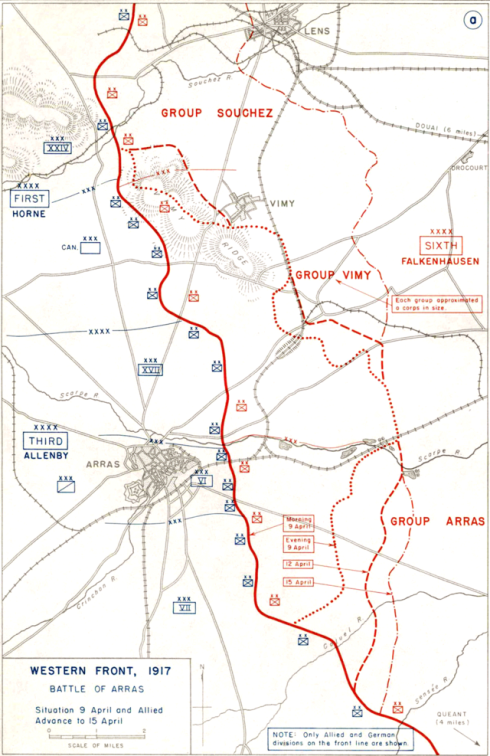
So why did the Canadians succeed where others failed? In a word – planning. The Canadians arrived at Vimy Ridge in the fall of 1916 and by the late winter of 1917 knew they were being assigned to take the ridge. Canadian and British generals, relying on the experiences of the French drew up a battle plan. Maps made from aerial photographs of the area were critical.
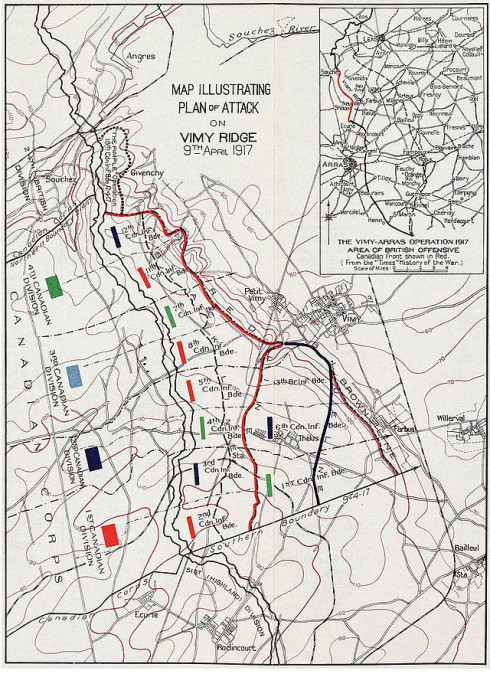
Note the four coloured rectangles. These were the four Canadian Divisions, fighting together as the Canadian army for the first time ever. All told there were just under 100,000 of us there and we were supported by another 60,000 or so British artillerymen and engineers. As Phil explained it, these were the key components to the Canadian success:
1. The battle plan was distributed to every soldier. Instead of treating ordinary soldiers as disposable bodies, Canadians were treated by their superiors as living, thinking beings who would be critical to the success or failure of the operation.
2. Every man knew not only what his job was, but his immediate superior’s as well. Thus if a captain was killed his lieutenant could take over and so on down the line.
3. The battle plan was rehearsed over and over and over until everyone knew exactly what they were expected to do.
4. The troops were brought to the front via tunnels so they did not have to cross hundreds of yards of No Man’s Land exposed to enemy machine gun fire.
5. The creeping barrage had been perfected as a much better way of softening up enemy defences in advance of an attack.
I’d like to add a 6th – that Canadians were braver, stronger, more intelligent etc. than others, but that would be untrue. No country had a monopoly on these traits, however, I do think the fact that Canada was not a class society like Britain, meant that there was more commonality among the Canadians and a unified sense of purpose in the Vimy Ridge attack.
Vimy Ridge was taken over three days of horrendous fighting in which there were 10,000 Canadian casualties, 3,598 of them killed outright. Despite this horrible cost, we did prove that as a country we could be as effective a fighting force as there was in this terrible war.
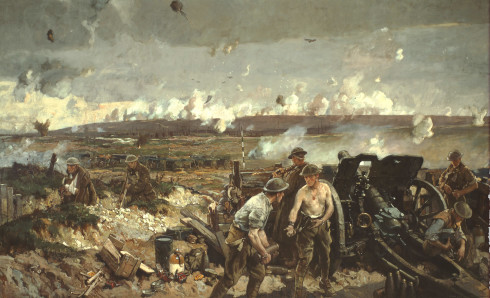
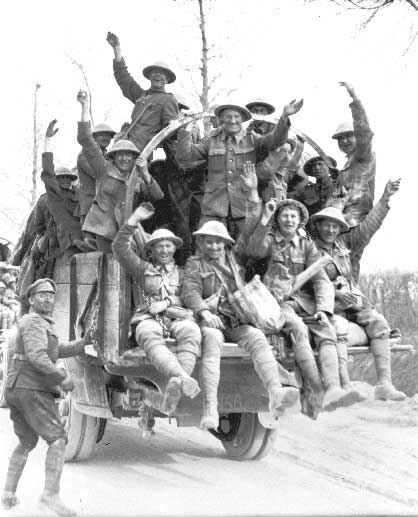
Vimy Ridge Memorial
With those thoughts in mind I get off the bus and get my first look in over fifty years of the Canadian National Vimy Monument.
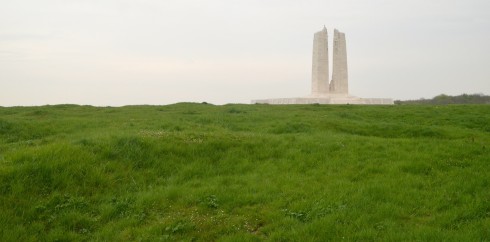
The monument was designed and the construction overseen by Canadian architect and sculptor Walter Seymour Allward on lands given to Canada by a grateful France. It was dedicated in 1936 and to my mind it is one of the most impressive and iconic war monuments anywhere.
We are here almost 98 years to the day of the Vimy Ridge battle and Phil points out that the weather on the morning of April 9, 1917 was just like it is today – cold and miserable. As we approach the monument via a treed walkway we stop and tour member and Canadian reservist Rob Alliston reads a passage from Pierre Berton’s Vimy. That’s Phil Craig beside him.
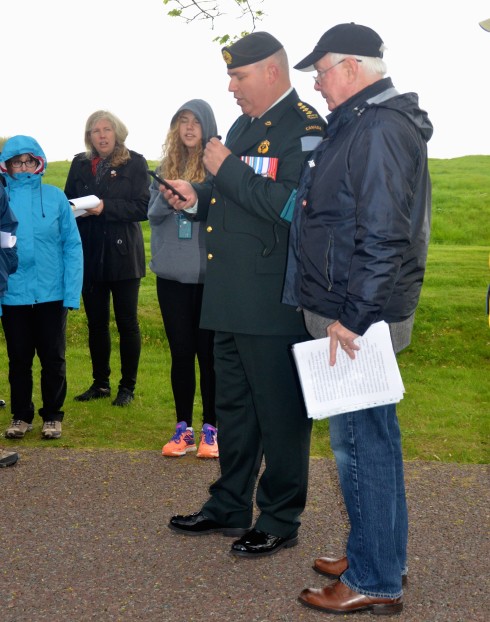
With that the group disperses and we have an hour to visit the monument and then make our way to the Visitor Centre where we will regroup. Over that hour the weather improves and Alison and I wander about, without the feeling of dread and foreboding that we had at The Somme, Dieppe or even Juno Beach. I can’t explain why, but I do feel a sense of pride at being here. It may be because my grandfather and his brother fought here and returned for the monument dedication in 1936, that I feel a personal connection. It may be because as a young teenager my grandfather brought me here over fifty years ago. And it may be because I am a Canadian and am proud of what our men accomplished here, senseless as the whole war was. You can’t just turn your back on 3,598 dead Canadians and say it wasn’t worth it, at least not on this hallowed ground.
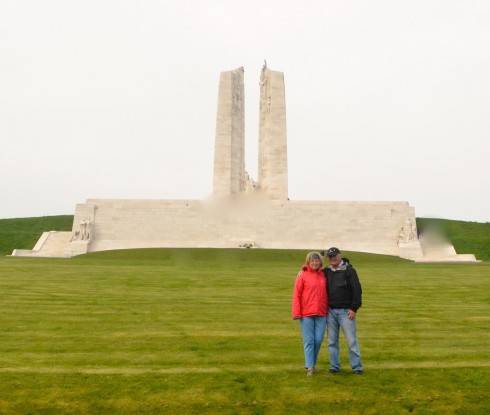
Up close, Allward’s sculptures are monumental (no pun intended) and moving.
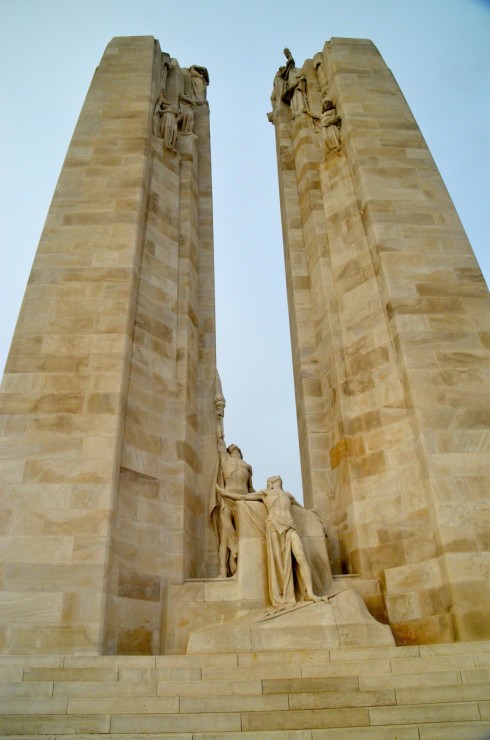
This is Mother Canada, who seems, in her bewilderment, to be asking, “Why?”
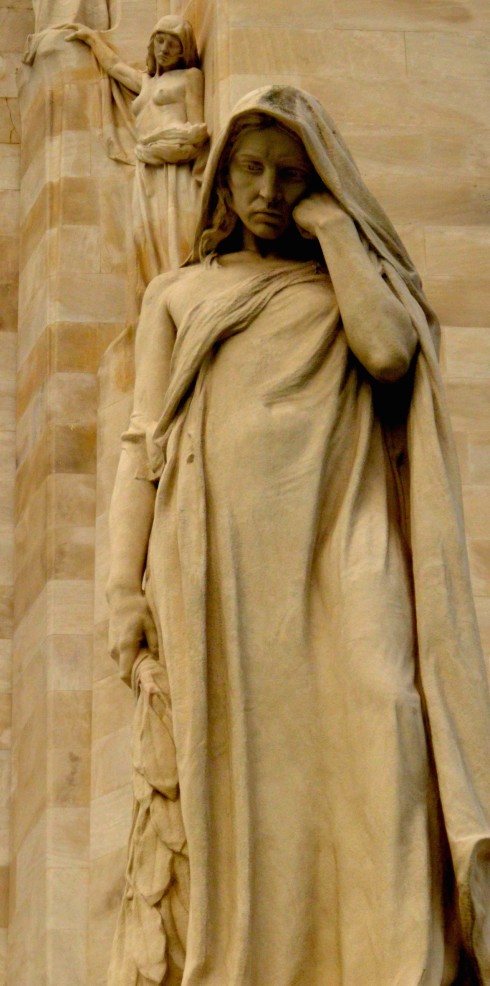
This is the Tomb of the Unknown Soldier at Vimy Ridge. People are still laying fresh flowers.
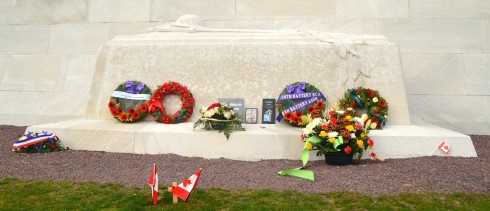
My sisters Kaye and Anne lay ceremonial poppies at the grave.
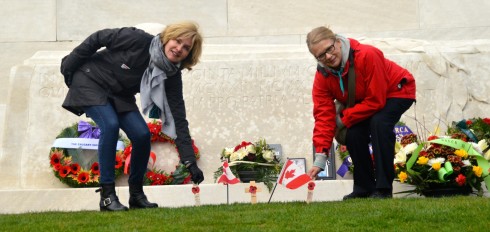
Walking away and looking back from what were the forward lines I feel as though I have made a Canadian’s version of a haj and that brings a sense of closure and tranquility. Maybe were are now a nation of peace keepers, but we had to go through a baptism of fire to get there.
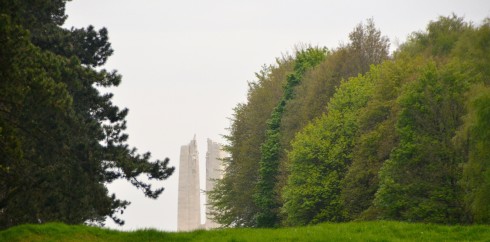
In the next post we’ll tour the Visitor Centre, the trenches and the tunnels of Vimy Ridge to get a better understanding of how this battle was won.

